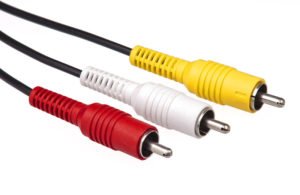In this article, we look at composite video signal: what it is, what cables to use, where composite video is used and the problems with it. This is the first in a series of articles outlining the different video signals used in home entertainment for connecting VCRs, DVDs, set top boxes, cameras and laptops to TVs and projectors.
What is Composite Video?
As the name suggests, composite video is “composed” of everything required to make up a TV picture. It has the basic black & white picture information (luminance or luma), along with the colour information (chrominance or chroma) as well as the timing information (sync). It is the most basic (and simplest) form of video signal.
Cables to use for Composite Video
 You are probably aware of the yellow, red and white connecting leads. The yellow one is generally used for composite video (the red and white ones are used for left and right sound). The plugs on each end are called RCA plugs, and these leads are normally called RCA leads, or AV leads (audio and video). These leads are good for short distances up to 5 metres (15 feet). For longer distances (to connect to a projector), thicker cable should be used for composite video signals. This larger cable is normally called RG59. It can be used for distances up to 100 metres. You can buy pre-made RG59 video cables in 5, 10, 15 and 20 metre lengths. For longer lengths, the cable is normally installed and then the connectors attached (soldered or crimped).
You are probably aware of the yellow, red and white connecting leads. The yellow one is generally used for composite video (the red and white ones are used for left and right sound). The plugs on each end are called RCA plugs, and these leads are normally called RCA leads, or AV leads (audio and video). These leads are good for short distances up to 5 metres (15 feet). For longer distances (to connect to a projector), thicker cable should be used for composite video signals. This larger cable is normally called RG59. It can be used for distances up to 100 metres. You can buy pre-made RG59 video cables in 5, 10, 15 and 20 metre lengths. For longer lengths, the cable is normally installed and then the connectors attached (soldered or crimped).
RCA comes from the company Radio Corporation of America. RCA originally used these plugs to connect phonographs (record player) to radio/amplifiers. Hence RCA plugs are also known as phono plugs.
Where Composite Video is used
Composite Video is used mostly for Standard Definition TV, and not for High Definition. Composite Video was used extensively in Video Cassette Recorders (VCRs) to connect to TVs. The familiar yellow RCA lead is simply connected from the yellow “Video Out” socket on the VCR to the yellow “Video In” at the back of the TV. Generally the red and white audio leads are connected to their respective coloured sockets for the audio. Longer video cables are also connected between a VCR and a projector.
As Composite Video is a basic video signal that all TVs and projectors can use, the familiar yellow “Video Out” socket is still available on DVD players and Set Top Boxes so that older TVs can still be connected to them.
Problems with Composite Video
A TV or projector needs to separate the various bits of picture information (luma, chroma and sync) in order to re-create the picture, and this is the problem with composite video. It is impossible to separate all the information back to the original quality once it has been mixed together in the one cable. This means the picture is not as crisp and the colours not as defined as they could be.
For a better understanding see the companion articles on S-video, RGB video, component video and HDMI.
